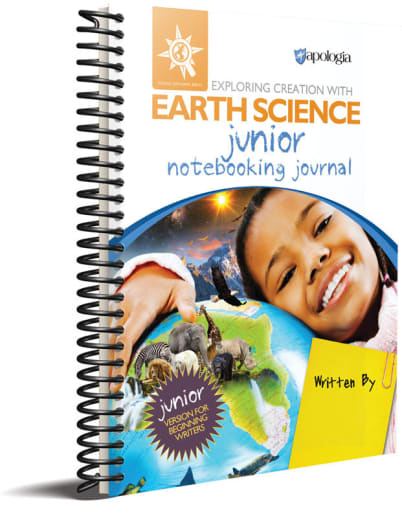Exploring Creation with Earth Science Junior Notebooking Journal
Description
A perfect complement to Exploring Creation with Earth Science, the Earth Science Junior Notebooking Journal provides everything your student needs to complete this study of earth science. The Junior Notebooking Journals can be used with multiple ages within a family with great ease. The Junior Notebooking Journals are specifically designed with the elementary student in mind. They are fun and interactive with an abundance of colorful, hands-on activities to add to your child's excitement with science. This Junior Notebooking Journal will serve as your child's individual notebook, providing a place for them to complete every assignment in the text. Each lesson begins with a coloring page for the student to color while he or she listens to the reading of the text. These pages provide opportunities for active learning while reinforcing the lesson's content. Following are pages with templates designed to encourage creative expression and written narration. The student can illustrate what they've learned and write a sentence or two about the topic. Next, the student is given the opportunity to work with and learn key vocabulary words presented in the text. Also included are helpful and easy-to-follow graphics, engaging mini-books, areas for creative writing, crosswords, and much more. These learning activities are not only interesting, but they also increase the student's retention of both the important terms and the subject matter presented in the lessons. To make planning a breeze, a detailed schedule is included in the Notebooking Journal and Junior Notebooking Journal. This schedule lists the pages to read in the textbook and the pages to complete in the journal.
The Benefits of Using the Junior Notebooking Journal
Keeping a scientific notebook has always been standard scientific practice. Apologia's Junior Notebooking Journals have been designed to:
- Facilitate retention and provide documentation of your student's education. The unique personal written and artistic expressions incorporate both sides of the brain
- Be flexible and allow for multilevel learning. A twelve-year-old student may write an essay and make an elaborate illustration, while a six-year-old may write one sentence with a stick-figure drawing
- Help students record experiences, observations, and thoughts
- Engage students in the scientific process
- Provide a written history that students can reference as they explore new subject areas
- Give your student a place where they can record and organize experiences and observations
- Provide a place to review their notes to create opinions and draw conclusions about the way their world works
This science study takes students on a journey into this wonderful planet we call home. From the galaxies above to the depths of the seas, children will learn more about the world around them, and the awesome God who created it! Filled with hands-on activities, this course offers fourteen modules teaching children about our observable universe, the atmosphere, hydrosphere, climate and weather, life cycle and so much more! One of the simpler activities that I absolutely love in this course is how children are shown what a frame of reference is, and how it appears that they are always in the center, even if they truly are not. What a life lesson for all of us! Other activities include making expanding universe thinking putty and creating a globe to map through their study. Written by Rachel Yunis, the co-author of the 2nd edition of Apologia's Exploring Creation with Advanced Biology. An excellent addition to the elementary line-up, providing homeschool families more options in their pursuit of a God-centered study of science. Hardcover.
For younger students or reluctant writers, the Junior Notebooking Journal requires less handwriting and provides more coloring pages, but other activities are similar. Additional supplements include Audiobooks in MP3 CD format and Lab Kits packaged by Nature’s Workshop. Most activities require only household items and other supplies. You can gather these yourself as needed, or purchase the kit for convenience. ~Deanne
| Product Format: | Paperback |
|---|---|
| Grades: | K-3 |
| Brand: | Apologia |
| ISBN: | 9781946506740 |
| Length in Inches: | 11 |
| Width in Inches: | 9.25 |
| Height in Inches: | 1 |
| Weight in Pounds: | 2 |

